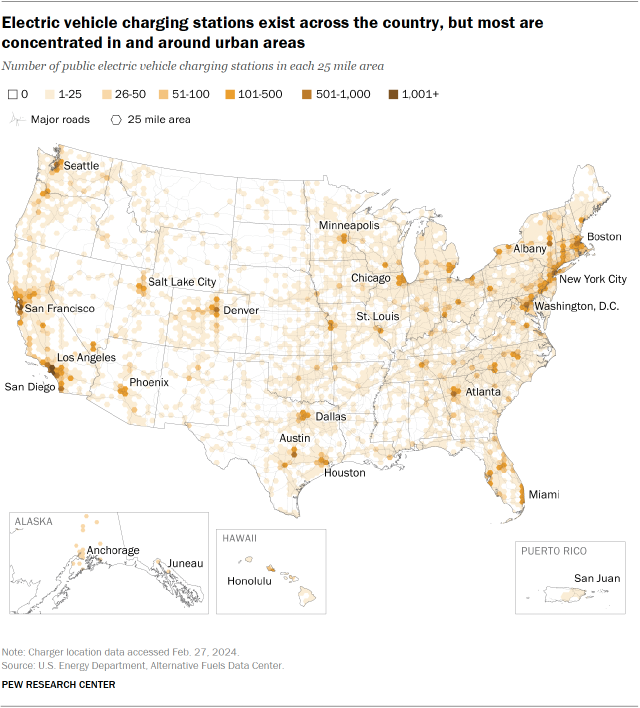Several recent laws, including the 2021 Infrastructure Investment and Jobs Act and the 2022 Inflation Reduction Act, have sought to encourage the development of electric vehicle infrastructure and increase the adoption of electric vehicles (EVs). And a Pew Research Center survey paired with an analysis of U.S. Department of Energy data finds that roughly six-in-ten Americans now live within 2 miles of a public charger. There were over 61,000 publicly accessible electric vehicle charging stations in the United States as of February 2024.
The vast majority of EV charging occurs at home, but access to public infrastructure is tightly linked with Americans’ opinions of electric vehicles themselves. Our analysis finds that Americans who live close to public chargers view EVs more positively than those who are farther away.
Even when accounting for factors like partisan identification and community type, Americans who live close to EV chargers are more likely to say they:
- Already own an electric or hybrid vehicle
- Would consider buying an EV for their next vehicle
- Favor phasing out production of new gasoline cars and trucks by 2035
- Are confident that the U.S. will build the necessary infrastructure to support large numbers of EVs on the roads
Here are some other key takeaways from our geographic analysis of EV chargers:
The number of EV charging stations has more than doubled since 2020. In December 2020, the Department of Energy reported that there were nearly 29,000 public charging stations nationwide. By February 2024, that number had increased to more than 61,000 stations. Over 95% of the American public now lives in a county that has at least one public EV charging station.
EV charging stations are most accessible to residents of urban areas: 60% of urban residents live less than a mile from the nearest public EV charger, compared with 41% of those in the suburbs and just 17% of rural Americans.
Distribution of EV charging stations in the U.S.
As of Feb. 27, 2024, there are more than 61,000 publicly accessible electric vehicle charging stations with Level 2 or DC Fast chargers in the U.S.1 That is a more than twofold increase from roughly 29,000 stations in 2020. For reference, there are an estimated 145,000 gasoline fueling stations in the country.
EV charging stations can be found in two-thirds of all U.S. counties, which collectively include 95% of the country’s population.

Who lives closest to EV charging stations?
The vast majority of Americans now live in a county with at least one public EV charging station, but some live closer to this infrastructure than others: 39% of Americans live within a mile of a public charging station, and 64% have a charging station within 2 miles of home.
Americans who live in cities are especially likely to have a public charging station very close to their home. Six-in-ten urban residents live within a mile of a public charger, compared with 41% of suburbanites and just 17% of rural Americans.
Because of this distribution, those who live closest to EV charging infrastructure tend to share the demographic characteristics of urban residents more broadly. For instance, they tend to be relatively young and are more likely to have a college degree than those in other community types.
Looking at political affiliation, 48% of Democrats and Democratic-leaning independents live within a mile of a public charger, compared with 31% of Republicans and Republican leaners.
However, there are no substantial differences in distance to the nearest charger by income. Similar shares of Americans with lower, middle and upper incomes live within a mile of public charging stations.
Attitudes toward EVs vary based on proximity to chargers
On the whole, the American public is fairly skeptical that the U.S. will be able to build the infrastructure necessary to support large numbers of EVs on the roads.
Just 17% of U.S. adults say they are extremely or very confident in the country’s ability to develop this infrastructure. But 20% of those who live within a mile of a public charger say they’re extremely or very confident that the U.S. will build the infrastructure necessary to support EVs, almost twice the share (11%) among those who live more than 2 miles from a charging station.
Likewise, those who live closer to public chargers are more likely to favor phasing out production of new gasoline cars and trucks by 2035. This view is held by 49% of those who live within a mile of a public charger, but just 30% of those who live more than 2 miles from one.
Owning – or considering – an electric vehicle
Americans who live near a public charger are a bit more likely to say they currently own an electric vehicle or hybrid. As of June 2023, 11% of those who live within a mile of a public charger said they owned an EV or hybrid; that figure is 7% for those who live more than 2 miles from a charging station.
Those who live close to public charging infrastructure are also much more likely to consider purchasing an EV in the future. Around half of those within a mile of a public charger say they are very or somewhat likely to consider purchasing an EV, compared with just 27% of those for whom the nearest charger is more than 2 miles away.
These trends persist if we look at urban, suburban and rural areas separately.3For instance, just 17% of rural Americans live within a mile of an EV charger, but those who do live close to one are substantially more likely to consider buying an EV in the future (33%) when compared with those who live more than 2 miles from the nearest charging station (21%).
Likewise, Democrats are much more likely than Republicans to say they’d consider buying an EV, but members of both parties are more willing to consider an EV when they live near charging infrastructure.
Just 15% of Republicans who live more than 2 miles from a charger say they are very or somewhat likely to consider an EV for their next vehicle purchase. But among Republicans who live within a mile of a charger, that share is 26%. And although 60% of Democrats living in close proximity to chargers say they’d consider buying an EV, that share drops to 50% among those whose nearest public charger is over 2 miles away.






























Discussion about this post